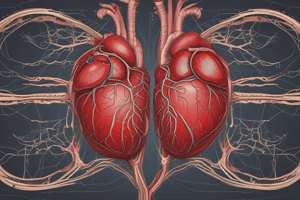Podcast
Questions and Answers
What is the primary function of the circulatory system?
What is the primary function of the circulatory system?
- To produce blood cells
- To regulate body temperature
- To transport oxygen and nutrients to cells and remove waste products (correct)
- To maintain blood pressure
What is the name of the muscular organ that pumps blood throughout the body?
What is the name of the muscular organ that pumps blood throughout the body?
- Lungs
- Brain
- Heart (correct)
- Liver
What are the three types of blood vessels?
What are the three types of blood vessels?
- Nerves, tendons, and ligaments
- Arteries, veins, and capillaries (correct)
- Arteries, veins, and muscles
- Bones, cartilages, and joints
Which component of blood carries oxygen from the lungs to the body's tissues?
Which component of blood carries oxygen from the lungs to the body's tissues?
What is the process by which oxygen-depleted blood from the body returns to the heart, then to the lungs to pick up oxygen?
What is the process by which oxygen-depleted blood from the body returns to the heart, then to the lungs to pick up oxygen?
What is the function of the circulatory system that helps to maintain a stable body temperature?
What is the function of the circulatory system that helps to maintain a stable body temperature?
How many times does the heart beat per day?
How many times does the heart beat per day?
What is the function of the circulatory system that involves removing waste products from cells and tissues?
What is the function of the circulatory system that involves removing waste products from cells and tissues?
Flashcards are hidden until you start studying
Study Notes
Circulatory System
Overview
- The circulatory system, also known as the cardiovascular system, is responsible for transporting oxygen and nutrients to cells and removing waste products.
- It consists of the heart, blood vessels, and blood.
Heart
- The heart is a muscular organ that pumps blood throughout the body.
- It is divided into four chambers: left and right atria, and left and right ventricles.
- The heart beats around 100,000 times per day, pumping approximately 2,000 gallons of blood.
Blood Vessels
- There are three types of blood vessels:
- Arteries: carry oxygenated blood away from the heart to the rest of the body.
- Veins: carry deoxygenated blood back to the heart.
- Capillaries: allow for the exchange of oxygen and nutrients with cells.
Blood
- Blood is a liquid tissue that consists of:
- Plasma: a liquid portion that carries proteins, nutrients, and waste products.
- Red Blood Cells (RBCs): carry oxygen from the lungs to the body's tissues.
- White Blood Cells (WBCs): part of the immune system, helping to fight infections.
- Platelets: involved in blood clotting.
Blood Circulation
- The circulatory process involves:
- Pulmonary circulation: oxygen-depleted blood from the body returns to the heart, then to the lungs to pick up oxygen.
- Systemic circulation: oxygen-rich blood from the lungs returns to the heart, then is pumped to the rest of the body.
Functions
- The circulatory system performs several critical functions:
- Oxygenation: delivers oxygen to cells and tissues.
- Nutrient delivery: transports nutrients from the digestive system to cells.
- Waste removal: removes waste products from cells and tissues.
- Regulation of body temperature: helps to maintain a stable body temperature.
- Maintenance of pH balance: helps to regulate the body's acid-base balance.
Circulatory System
Overview
- Responsible for transporting oxygen and nutrients to cells and removing waste products
- Consists of the heart, blood vessels, and blood
Heart
- Muscular organ that pumps blood throughout the body
- Divided into four chambers: left and right atria, and left and right ventricles
- Beats around 100,000 times per day, pumping approximately 2,000 gallons of blood
Blood Vessels
- Three types of blood vessels:
- Arteries: carry oxygenated blood away from the heart to the rest of the body
- Veins: carry deoxygenated blood back to the heart
- Capillaries: allow for the exchange of oxygen and nutrients with cells
Blood
- Liquid tissue consisting of:
- Plasma: liquid portion that carries proteins, nutrients, and waste products
- Red Blood Cells (RBCs): carry oxygen from the lungs to the body's tissues
- White Blood Cells (WBCs): part of the immune system, helping to fight infections
- Platelets: involved in blood clotting
Blood Circulation
- Pulmonary circulation: oxygen-depleted blood from the body returns to the heart, then to the lungs to pick up oxygen
- Systemic circulation: oxygen-rich blood from the lungs returns to the heart, then is pumped to the rest of the body
Functions
- Oxygenation: delivers oxygen to cells and tissues
- Nutrient delivery: transports nutrients from the digestive system to cells
- Waste removal: removes waste products from cells and tissues
- Regulation of body temperature: helps to maintain a stable body temperature
- Maintenance of pH balance: helps to regulate the body's acid-base balance
Studying That Suits You
Use AI to generate personalized quizzes and flashcards to suit your learning preferences.




